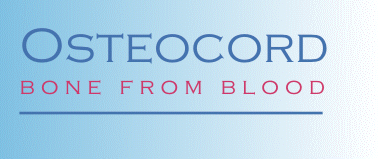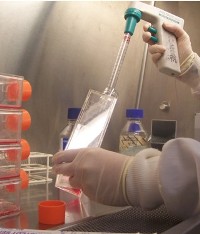A European Union 6th Framework funded project with €2.5 million funding over 3 years |
Project Workpackages
Osteocord has seven workpackages within the four overlapping phases of the project.
| 1. | Acquisition of stem cells CB-MSCs and BM-MSCs will be isolated following standardised protocols, based on previously published research, which will also be distributed as part of this workpackage. Two ES cell lines will also be propagated according to standardised protocols. This workpackage will be initiated before other work is commenced and cells will be cryopreserved in dedicated liquid nitrogen freezers to meet the demands of the different workpackages.
|
|
| 2. | Characterisation of CB-MSCs
|
|
| 3. | Self-renewal and expansion of CB-MSCs CB-MSC expansion potential will be determined using in vitro assays of populations doubling times, telomerase activity and telomere length. Novel technologies will be applied to promote CB-MSC expansion, in combination with purpose-designed bioreactors and optimised for GMP-standard scale-up. CB-MSC lines will be generated.
|
|
| 4. | Osteogenic differentiation of CB-MSCs Osteogenic programmes have previously been designed for CB-MSCs, BM-MSCs and ES cells. The rate and extent of osteogenic differentiation of these cell types will be determined in parallel 2D cultures using defined and measurable readouts. 3D spheroid cultures will be developed using rotation techniques, which will additionally be subjected to osteogenic induction.
|
|
| 5. | Biocompatibility of CB-MSCs The aim of this workpackage is to assess the suitability of CB-MSCs for in vivo therapy, specifically targeted towards bone repair applications. Labelled CB-MSCs will be intravenously administered to immunocompromised mice, with follow-up tissue tracking to determine their homing and engraftment potential. A built-for purpose scaffold will be designed and produced, with modified surface properties and growth factor release characteristics, to support CB-MSCs and their osteogenic differentiation. The adhesion, spreading, proliferation and differentiation of CB-MSCs on the custom-built scaffolds will initially be determined in vitro using molecular, cellular and microscopically analyses. Finally, CB-MSC-seeded scaffolds, pre- and post-osteogenic induction, will be implanted subcutaneously into immunocompromised mice to determine in vivo biocompatibility.
|
|
| 6. | Analysis of expectations, prospects and potential MSCs present a broad set of difficulties to the research community. Whilst being a source of great promise, uncertainties remain in respect to questions of safety and standards, commercial viability, potential investment, consensus amongst scientists, clinical diffusion, and so on. This Workpackage is an opportunity to link the scientific questions (of MSC isolation and expansion) to the wider environment, surveying the different expectations of key stakeholders and defining plausible scenarios, potential barriers and areas of weakness.
|
|
| 7. | Project synthesis and dissemination Annual progress reports will be provided for each of the workpackages, which will be integrated into a single document and a final report will provide a detailed account of our findings. Six-monthly newsletters will be produced for distribution to interested parties and a website will provide an accessible reference point describing all aspects of the research. Within the first six months of the work programme, a report on the bioethical issues raised by the proposed research will be produced, including the use of human tissues, umbilical cord blood, embryonic stem cells, potential benefits of the research weighed against ethical and moral considerations. A subsequent ethical evaluation will be produced at the end of the study to determine to what extent our research and influenced the initial ethical considerations. |
|

